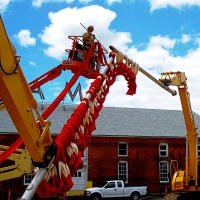One Row At A Time: Knitting An American Flag
 |
| Excavators and aluminum light poles assist artist Dave Cole and his assistant Joel Taplin knit an American flag. |
 |
| Excavators and aluminum light poles assist artist Dave Cole and his assistant Joel Taplin knit an American flag. |
| If you would like to contribute information on this article, contact us at info@iberkshires.com. |